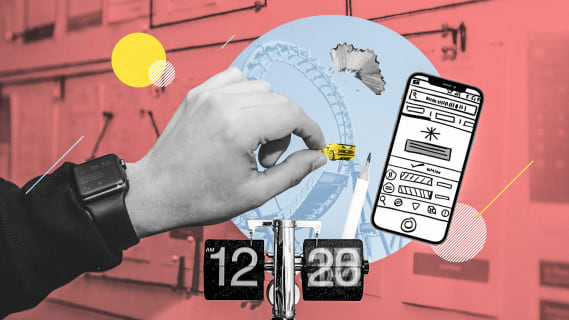Meet the Product-Market Fit team at Boldare
What are the duties of the Product-Market Fit team at Boldare? What kind of ups and downs do they face in their work? If you want to know the answers, read this conversation with Ula Augustyniak - Senior Product Designer and member of the Product-Market Fit team.

Table of contents
Tell us in a few words, what exactly do you do at Boldare?
Above all, I design digital products and act as a member of an interdisciplinary scrum team. I cooperate with scrum developers and clients (who assume the role of product owner).
What are my other responsibilities? I create aesthetic and usable interfaces of digital products. Also, I work on product development strategy with the product owner and the whole team. My job requires UI/UX skills, market knowledge and business awareness.
Another crucial part of my work is collecting users’ feedback and working with quantitative data. It would be hard to make accurate decisions that impact product development without data-informed approach.
The process of building products at Boldare is divided into phases within the overall “Full Cycle Product Development” process. What does that mean?
Full Cycle Product Development is an approach inspired by the Lean Startup methodology. We build digital products in phases, add new features progressively, and regularly test increments and global solution with the market. Depending on the development phase, each team has different goals to achieve.
At the beginning of building a product, it is crucial to confirm that there’s a real need for that particular solution on the market. We call this phase a prototype.What is interesting is that we often can create a prototype without code. It can be a low-fidelity prototype or a promotional film that describes the further product. The goal is more important than the form, as the main aim is to validate the research hypothesis.
When the hypotheses have been validated, and we know that there’s real need on the market, we move to the MVP (minimum viable product) stage. This phase consists of building the version of the functioning product with core functionalities. It allows us to test whether the main assumption and solution will attract the target group. In this phase, we also validate if the product is viable—able to be monetized.
If the MVP stage confirms our assumptions, we can jump to the PMF stage (product-market fit). PMF focuses on product improvements and optimizing our business model as well. The team’s main goal is to tailor a product to the user’s needs and preferences. How can we measure that? If the users begin to use the app regularly, they are willing to pay for the product and recommend the product, we can say that the PMF stage has achieved its purpose.
The last step in building a product is scaling. At this stage, we can face various challenges, depending on the individual needs of the business. Sometimes, we adjust the solution to a wider target group. Other times, we focus on developing new functionalities. Usually, scaling is the result of upgrading the client’s business model (e.g., adding some new services) or expanding the solution to appeal to new markets. The team’s goal is also to search for new ways of growth, which is an intriguing experience.
The four phases of product development that I’ve mentioned above (Prototype, MVP, PMF, Scaling) combine to make one full cycle – Full Cycle Product Development. Overall, it looks linear, however this model could be applied also within the stages. Take the example of adding a new feature to a complex, scalable product. Before implementation, we need to validate if there is a real need for the feature. Then we create the basic version of the function. So, although we are in the scaling phase already, we apply prototyping and MVP activities while building this new feature.
Why does Boldare use Full Cycle Product Development and what value does it bring to the team and the client?
The best value that Full Cycle Product Development brings to the client is an in-depth adjustment of the strategy, approach, and tools to the specific product’s goals, geared to each particular stage of development. Compare validating a completely new idea on the market and preparing an app for one million users – you will use different tools and actions. In addition, dividing product development into phases allows the carrying out of regular tests, mitigating the risk of mistakes or financial loss. If the concept of the ‘product of a lifetime’ turns out to be a failure, it’s better to know this after an interview with a user in prototype phase, not after a year of pressing development.
And how does the team of developers benefit from this approach?
Each phase of Full Cycle Product Development requires a different approach and mindset. Therefore, we’ve built specialist teams dedicated to each of the several stages of FCPD. Each of them has a unique work culture and set of processes. Thus, we can work in the environment where we fit best and feel most comfortable.
If you like to work in a dynamic environment, test various technologies and change products often, I recommend Rapid Services. This team works on the first stages of the product building process: prototypes and MVPs. In turn, if you like to conduct a lot of experiments to optimise product, and you have an explorer sort of nature, you will fit product-market fit work better. And if you want to combine exploring new product growth opportunities with your knowledge in a particular technology or seek out architectural challenges — then you should choose scaling.
Working in FCPD allows us to concentrate on crucial aspects of the product and makes prioritization of tasks easier. Thanks to this diversification, we can focus on the things that let each of us be at the top of our game. We can use our expertise in proper space.
In what team do you operate? What is the main goal of your team?
Currently, I belong to the PMF team. We join our forces to strengthen the product’s position on the market. The PMF team aims to make an application recognizable and regularly used. Therefore, we carefully investigate user behaviours, needs, and preferences to answer the question: how to get the product to become the first choice for the target group? In line with this, we conduct lots of tests and experiments, validate hypotheses and analyse the impact of every single implemented change on user behaviour.
How do we know whether we succeeded? We have achieved product-market fit when users buy and product regularly, and… recommend it to others.
How does the PMF team differ from the others?
What is characteristic in PMF is that people are constantly looking for a niche and place in the market. That is why PMF members need to have a passion to explore. We continuously validate theses and solution proposals in relation to users’ needs. Our job is to search for new paths and possibilities for product development, based on the collected data. Elasticity and openness to change are essential to work here.
What do you like the most about working on PMF?
The aspect I enjoy the most working on PMF is the endless opportunity to investigate user behaviour. I like to work in a data-informed approach and base my decisions on data, and I enjoy analysis. We work with qualitative and quantitative data on our team.
The basic tools that I use at my work are Google Analytics, Hotjar, Amplitude, interviews, A/B tests, and card sorting. Of course, there are more tools. It depends on what is needed to validate a particular thesis.
Each member of the PMF team becomes a sort of explorer. Working here comes down to continuous discovery. I love the moment when, studying data from user interviews, I notice the new opportunity for product growth or significantly embed the solution in its market niche.
How inspiring! But on balance, tell us what are the biggest challenges that PMF faces?
The biggest challenge that we face is appropriate prioritization, I suppose. Sometimes, it’s hard to find a balance between exploring new possibilities and adding new functionalities, fixing errors and implementing improvements to features.
For some, variability can turn out to be a difficulty. We need to stay open regularly observe market movement and users behaviour, analyse data and adapt regularly.
Who would be a perfect fit for this team?
Above all, those who are inquisitive and like to search for new solutions will feel good on this team. This is a space for people who are open to an experimental environment (with hypothesis testing and test cards included).
PMF is a place for the data-informed, who base their decisions on information that we acquire from users. Working here, we are in a permanent state of analysis, of metrics and statistics. In the next step, there is a conversion to practical conclusions.
Who wouldn’t feel comfortable on this team?
I suppose those who need constancy and routine wouldn’t feel good working on PMF. After all, it’s a very experimental environment. Although it’s worth saying that openness to change is essential at every stage of FCPD because this process is based on an agile way of product delivery.
Thank you for all your answers! One more to finish: what would you say to those who want to join the PMF team?
If you want to join our team, deepen your knowledge regarding conducting experiments, testing hypotheses and investigating users’ behaviours. Familiarity with Lean Startup and the market (where we implement the particular product) is also useful.
Share this article:







